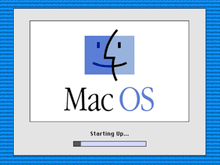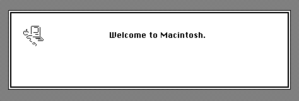Macintosh startup
The classic Macintosh startup sequence included the startup chime, Happy Mac, Sad Mac, and Chimes of Death. These had all been done away with over time, and the release of the 2016 MacBook Pro eliminated the final remaining startup feature: the startup chime,[1] in favor of a more discrete sequence with a black background and no audible indicators, despite its use as a security feature that provided a user-friendly, audible verification that a computer's NVRAM configuration is authentic.[2][3] Apple added the startup chime back for the release of the 2017 MacBook Air.[4]
Startup chime
The Macintosh startup chime is a single chord simply known as "the startup sound." The sound used differs depending on the ROM, which greatly varies depending on model type. This short sound is played when an Apple Macintosh computer is turned on. The sound indicates that diagnostic tests run immediately at startup have found no hardware or fundamental software problems.[5]
Mark Lentczner created the code for the arpeggiated chord used on the Macintosh II. Variations of this sound were used until Jim Reekes created the startup chime used for the Quadra 700 through the Quadra 800.[6] Reekes said, "The startup sound was done in my home studio on a Korg Wavestation EX.[7]It's a C major chord, played with both hands stretched out as wide as possible (with 3rd at the top, if I recall)." He was also the creator of the iconic (or "earconic", as he calls it) "bong" startup chime used in most Macintoshes since the Quadra 840AV. A slightly lower-pitched version of this chime was used on all PCI-based Power Macs until the iMac G3. The Macintosh LC, LC II, and Macintosh Classic II do not use the Reekes chime, instead using an F major chord that just produces a "ding" sound. The first generation of Power Macintosh computers also do not use the Reekes chime, instead using a chord strummed on a Yamaha 12-string acoustic guitar by jazz guitarist Stanley Jordan. Further, the Power Macintosh 5200–6300 computers (excluding the 5400 and 5500, which have the "bong" chime) use a unique chime, and the 20th Anniversary Macintosh uses another unique sound.
For models built prior to the introduction of the Power Macintosh in 1994, a Sad Mac icon, an error code, and distinctive sounds, are displayed on failure of initial self-diagnostic tests. This phenomenon is referred to as the "Chimes of Death".
The chime for all Mac computers since 1999 is the same chime used first in the iMac G3. The chord is a F-sharp major chord, and was produced by pitch-shifting the 840AV's sound. The Mac startup chime is now a registered trademark in the United States,[8] and is featured in the 2008 film WALL-E when the titular robot character is fully recharged by solar panels as well as in the 2007 Brad Paisley song "Online."[9]
As of 2016, Apple has removed the startup chime starting with the late 2016 MacBook Pro.[10] Apple has since updated its support documentation to reflect this change, removing references to the startup chime from the NVRAM reset instructions for this model.[11]
Happy Mac


A Happy Mac is the normal bootup (startup) icon of an Apple Macintosh computer running older versions of the Mac operating system. It was designed by Susan Kare in the 1980s, drawing inspiration from the design of the Compact Macintosh series and from the Batman character Two-Face.[12] The icon remained unchanged until the introduction of New World ROM Macs, when it was updated to 8-bit color. The Happy Mac indicates that booting has successfully begun, whereas a Sad Mac (along with the "Chimes of Death" melody or one or more beeps) indicates a hardware problem.
When a Macintosh boots into Mac OS 9 or lower, the system will play its startup chime, the screen will turn gray, and the Happy Mac icon will appear, followed by the Mac OS splash screen (or the small "Welcome to Macintosh" screen in System 7.5 and earlier), which underwent several stylistic changes. Mac OS versions 8.6 and later also includes the version number in this splash screen (for example, "Welcome to Mac OS 8.6").
On early Macs that had no internal hard drive, the computer boots up to a point where it needs to load the operating system from a floppy disk. Until the user inserts the correct disk, the Mac displays a floppy icon with a blinking question mark. In later Macs, a folder icon with a question mark that repeatedly changes to the Finder icon is shown if a System Folder or boot loader file cannot be found on the startup disk.
With the introduction of Mac OS X, in addition to the blinking system folder icon, a prohibition icon was added to show an incorrect OS version found. The bomb screen was replaced with a kernel panic, which was originally colored white but was changed to black in version 10.3. With Mac OS X 10.1, a new Happy Mac was included. This is also the last version that had a Happy Mac icon; in version 10.2, the Happy Mac symbol was replaced with the Apple logo.
The Face ID logo for the iPhone X was based off the Happy Mac.
Sad Mac

A Sad Mac is a symbol used by older-generation Apple Macintosh computers (hardware using the Old World ROM and not Open Firmware, which are those predating onboard USB), starting with the original 128K Macintosh and ending with the last NuBus-based Power Macintosh models (including the first-generation 6100, 7100, 8100, as well as the PowerBook 5300 and 1400),[13] to indicate a severe hardware or software problem that prevented startup from occurring successfully. The Sad Mac icon is displayed, along with a set of hexadecimal codes that indicate the type of problem at startup. Different codes are for different errors. This is used in place of the normal Happy Mac icon, which indicates that the startup-time hardware tests were successful. In 68k models made after the Macintosh II, the Chimes of Death are played.
Models prior to the Macintosh II crash silently and display the Sad Mac, without playing any tone. PowerPC Macs play a sound effect of a car crash, and computers equipped with the PowerPC upgrade card use the three note brass fanfare death chime (A, E-natural, and E-flat) same as the Macintosh Performa 6200 and Macintosh Performa 6300.
A Sad Mac may be deliberately generated at startup by pressing the interrupt switch on Macintosh computers that had one installed, or by pressing Command and Power keys shortly after the startup chime. On some Macintoshes such as PowerBook 540c, if the user presses the command and power keys before the boot screen displays, it will play the "chimes of death". The chimes are a fraction of normal speed and there is no Sad Mac displayed.
Old World ROM Power Macintosh and PowerBook models based on the PCI architecture do not use a Sad Mac icon and will instead only play the error/car-crash sound on a hardware failure (such as missing or bad memory, unusable CPU, or similar).
Mac OS X 10.2 and later use a Universal "no" symbol to denote a hardware or software error that renders the computer non-bootable.[14][15]
Sad iPod
On the iPod, if damage or an error occurs in the hardware or the firmware, for example, if its files are deleted, a Sad iPod appears. This is similar to the Sad Mac, but instead of a Macintosh, there is an iPod, and there are no chimes of death. The icon also lacks a nose, and the frown is flipped horizontally. It also does not show hexadecimal codes indicating what problem occurred in the iPod. This error screen will not show up when a problem occurs in the newer iPods.
Chimes of Death
The Chimes of Death are the Macintosh equivalent of a beep code on IBM PC compatibles. On all Macintosh models predating the adoption of PCI and OpenFirmware, the Chimes of Death are often accompanied by a Sad Mac icon in the middle of the screen.
Different Macintosh series used different death chimes. The Macintosh II was the first to use the death chimes (an upward major arpeggio, with different chimes on many models). The Macintosh Quadra, Centris, Performa, LC and the Macintosh Classic played the upward major arpeggio, followed by three or four notes, with slight variation depending on the model of the Macintosh. The Macintosh Quadra AV660 and Centris AV660 used a sound of a single pass of Roland D-50's "Digital Native Dance" sample loop, while the NuBus based Power Macintosh models (including 6100, 7100, and 8100) series used a car crash sound. The Power Macintosh and Performa 6200 and 6300 series, along with the Power Macintosh upgrade card, used an eerily dramatic 3-note brass fanfare with a rhythm of drums and cymbals. The PowerBook 5300, 190, and 1400 used the second half of the 8-note arpeggio as found on the Quadra and Centris models, or the entire death chime if the error occurred before the screen lights up. The pre-G3 PCI Power Macs, the beige G3 Power Macs, the G3 All-In-One, and the PowerBook 2400, 3400 and G3 all used a sound of a firecracker mixed with a metal pipe being struck, making it sound like something just exploded inside the machine when power was applied; these models did not display a Sad Mac icon. Since the introduction of the iMac in 1998, the Chimes of Death are no longer used and were replaced with a series of tones to indicate hardware errors.
See also
References
- ↑ https://support.apple.com/en-us/HT202768
- ↑ http://www.hackaapl.com/how-to-reset-nvram-on-a-macbook-pro/
- ↑ https://wikileaks.org/ciav7p1/cms/page_26968097.html
- ↑ https://support.apple.com/en-us/HT202768
- ↑ Inside Macintosh: The Startup Process. Retrieved September 3, 2011
- ↑ Whitwell, Tom (May 26, 2005) "Tiny Music Makers: Pt 4: The Mac Startup Sound", Music Thing
- ↑ Pettitt, Jeniece (2018-03-24). "Meet the man who created Apple's most iconic sounds: Sosumi, the camera click and the start-up chord". CNBC. Retrieved 2018-03-24.
- ↑ "Apple's Classic Mac Startup Chime is now a Registered Trademark". Patently Apple. December 12, 2012. Retrieved October 30, 2016.
- ↑ Apple Sound Designer on Iconic Startup Sound. Obama Pacman. March 10, 2010. Retrieved January 24, 2011.
- ↑ Classic Mac Startup Chime Not Present in New MacBook Pros. Mac Rumors. October 30, 2016. Retrieved October 30, 2016.
- ↑ How to reset NVRAM on your Mac Apple. October 28, 2016. Retrieved October 30, 2016
- ↑ Hertzfield, Andy (November 19, 2011). Revolution in The Valley [Paperback]: The Insanely Great Story of How the Mac Was Made. O'Reilly Media. ISBN 978-1-4493-1624-2.
- ↑ "Macintosh: "Sad Macintosh" Error Code Meaning". Apple. November 30, 2003. Archived from the original on June 17, 2009. Retrieved August 24, 2008.
- ↑ OS X: "Broken folder" icon, prohibitory sign, or kernel panic when computer starts. Apple.
- ↑ Delio, Michelle (August 2, 2002). "'Happy Mac' Killed By Jaguar". Wired.com. Archived from the original on February 4, 2011.
External links
- The Original Macintosh: Boot Beep – Folklore.org